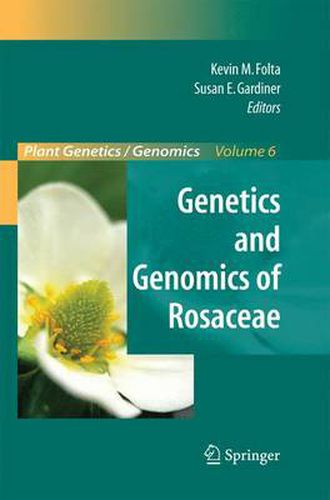Readings Newsletter
Become a Readings Member to make your shopping experience even easier.
Sign in or sign up for free!
You’re not far away from qualifying for FREE standard shipping within Australia
You’ve qualified for FREE standard shipping within Australia
The cart is loading…






This title is printed to order. This book may have been self-published. If so, we cannot guarantee the quality of the content. In the main most books will have gone through the editing process however some may not. We therefore suggest that you be aware of this before ordering this book. If in doubt check either the author or publisher’s details as we are unable to accept any returns unless they are faulty. Please contact us if you have any questions.
The Rosaceae Family is represented by approximately 3,000 species of diverse plants, primarily con?ned to temperate climates. The family has a rich variety of architectural forms and contains herbaceous, tree and shrub species. Many family members are readily recognizable because of their edible seasonal fruits that are prized for their unique ?avors, colors and nutritious properties (e.g. apple, str- berry, raspberry, pear, cherry, plum, apricot, pear), as well as familiar ornamentals (e.g. roses) and nuts (e.g. almonds). Today’s rosaceous cultivars have been derived from centuries of careful sel- tion and breeding, using a palette of some of evolution’s most curious creations. The careful sculpting that has transformed the germplasm was not trivial, as several of the most coveted fruit species maintain complicated genomes-in some cases among the most complex of cultivated plants (e.g. strawberry). Other species in the family are represented by large perennial tree crops that exhibit substantial juven- ity phases, posing a barrier to standard breeding and genetic analyses. Yet, today’s superiorcultivarsfeaturerobustgrowth,substantialyieldsandresistancetocommon biotic and abiotic stresses; traits fostered by human intervention. When the hurdles to ef?cient cultivation, breeding and selection are considered, the quality and qu- tity of rosaceous plant products derived from traditional breeding techniques is little short of amazing.
$9.00 standard shipping within Australia
FREE standard shipping within Australia for orders over $100.00
Express & International shipping calculated at checkout
This title is printed to order. This book may have been self-published. If so, we cannot guarantee the quality of the content. In the main most books will have gone through the editing process however some may not. We therefore suggest that you be aware of this before ordering this book. If in doubt check either the author or publisher’s details as we are unable to accept any returns unless they are faulty. Please contact us if you have any questions.
The Rosaceae Family is represented by approximately 3,000 species of diverse plants, primarily con?ned to temperate climates. The family has a rich variety of architectural forms and contains herbaceous, tree and shrub species. Many family members are readily recognizable because of their edible seasonal fruits that are prized for their unique ?avors, colors and nutritious properties (e.g. apple, str- berry, raspberry, pear, cherry, plum, apricot, pear), as well as familiar ornamentals (e.g. roses) and nuts (e.g. almonds). Today’s rosaceous cultivars have been derived from centuries of careful sel- tion and breeding, using a palette of some of evolution’s most curious creations. The careful sculpting that has transformed the germplasm was not trivial, as several of the most coveted fruit species maintain complicated genomes-in some cases among the most complex of cultivated plants (e.g. strawberry). Other species in the family are represented by large perennial tree crops that exhibit substantial juven- ity phases, posing a barrier to standard breeding and genetic analyses. Yet, today’s superiorcultivarsfeaturerobustgrowth,substantialyieldsandresistancetocommon biotic and abiotic stresses; traits fostered by human intervention. When the hurdles to ef?cient cultivation, breeding and selection are considered, the quality and qu- tity of rosaceous plant products derived from traditional breeding techniques is little short of amazing.